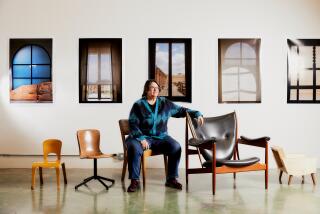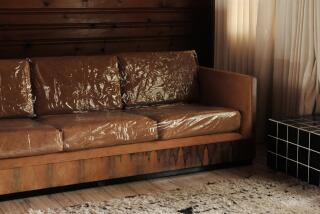Plus-size furniture grows with America’s girth
- Share via
It can be a bit delicate to ask a furniture shopper: “Oh, sir, um, maybe, ah, you’d like to see something a bit, hmmm, sturdier?”
We are, as a people, as a sitting-in-chairs public, big. Bigger than we ought to be, health authorities frequently tell us. And bigger than many standard chairs of years past were made to hold comfortably.
So the scale of furniture has increased over the last decade — to suit both the size of homes and the size of their occupants, said Max Shangle, professor and chairman of the furniture design department at Kendall College of Art and Design in Michigan.
Some plus-size furniture proudly flaunts its generous proportions, but in many cases, manufacturers and retailers rely on subtle marketing.
Shangle said he knew of a company that made a “wonderful” dining room table and chairs, but the chairs were a bit fragile. So the company added three other styles of seating, including a bench it said would suit families with children.
“In reality, the bench was for folks who wouldn’t fit in the chair,” Shangle said.
He also cited a popular “mother-daughter” chair, the chair-and-a-half advertised as a cozy spot for two people to sit. “I know full well the chair was also sold to folks for whom a single chair would be a little tight,” he said.
Consider those inexpensive folding chairs parents often tote to their kids’ soccer games, said Kevin McGrain, senior vice president and general brand manager of KingSize/BrylaneHome. His company did, and realized its customers could be left standing on the sidelines.
So it introduced the Plus Size Living Collection last year that includes a portable cloth chair that the company said can hold up to 800 pounds.
“The initial response was phenomenal,” McGrain said. The chair has a much stronger construction than the typical $40 version — and hence a higher price tag, about $100.
“It’s just like apparel,” McGrain said. “They don’t want to look or feel any different than the regular customer.”
Through furniture, observers can track changes over time in human size, home size and fashions. Chairs no longer need to accommodate hoop skirts, for example, and seat heights have gone up as humans have grown taller, Shangle said.
Of all American adults age 20 to 74, about 46% were overweight or obese in 1960, according to the National Center for Health Statistics. By 2005-06, that number had risen to about 73% for Americans 20 or older.
The growth of our girth has prompted the Business and Institutional Furniture Manufacturer’s Assn. to revise its test load standards used in the industry to evaluate product safety and durability. The standard for general purpose office chairs is now 250 pounds, up from 220.
“What we have noticed is people wanting bigger, more comfy, cozy sofas,” said Heather Neubaur, manager at the Room & Board store in Culver City, who emphasized that the demand was driven by all consumers, not just heavy people.
But Sal Alessandro, owner of Valley Leather Furniture in Encino, which makes custom couches and chairs priced from about $900 and up, said he has seen an increase in sales of furniture specifically for larger people.
“I have definitely sold more, because I use more of that heavy foam” — the sort of foam meant to keep from sinking under the weight of a person upward of 300 pounds, he said. Foams are classified by density and resilience; heavy foam has more substance and less air per cubic foot.
Cushioning is just one of the issues in making furniture for heavy customers. Unlike the stereotype of pratfalls, a heavy person isn’t likely to collapse a couch or an easy chair.
“I have yet to have a wood frame break,” said Denis Devlin, store manager at Munro’s Fine Furniture in Costa Mesa. “The biggest concern is the strength of the cushioning.”
So for a person who weighs more than 300 pounds, a couch frame is best constructed with eight-way hand-tied coils, several experts said.
Width is another consideration. Take Finnish designer Alvar Aalto’s classic 1933 Armchair 401, whose distinctive bent birch frame has a seat that’s 62.5 centimeters wide. Then look at IKEA’s popular Poang chair, nearly identical in form and launched about 40 years later. It’s 68 centimeters wide, and the company’s website said the chair was made to support up to 375 pounds.
Alessandro said he also looks at the depth of the sofa, from the back to where it hits the back of the knees; the height; the angle of the back cushions; and the placement of the arm rest. He asks a shopper to sit on some couches, and he looks at how they fit the furniture. Does the small of the back hit at the right spot? Are the feet comfortably on the floor? Is the back pillow high enough?
Shangle said the arms of a chair or sofa need to withstand the stress of being pulled or pushed by an overweight person getting up and down.
Francois Bruneau’s Canadian company, DFC Woodworks Inc., has for about a decade made an Adirondack chair called the Grand, with a 500-pound capacity and a seat that’s 2 inches wider than first-class airplane seats, he said.
“It came about from a dealer of mine,” Bruneau said. “The dealer was a bit larger, and he wanted a chair for himself and his sister. We started building a custom chair for him, and we said, ‘Wait a minute — there are a lot of bigger people out there.’ ”
Munro’s sells a recliner made by the Norwegian company Ekornes that comes in small, medium and large — the largest designed to hold up to 300 pounds, Devlin said. Munro’s also carries sturdy, elegant dining room furniture made by Amish craftsmen in Indiana that, while they don’t have a stated weight capacity, could hold just about anyone, he said.
McGrain and others said Chinese factory-made furniture generally has a one-size-fits-all approach, leaving larger customers with few choices.
But even big international companies can adapt. When IKEA first crossed the ocean to the land of large more than 20 years ago, it was in for a bit of a shock.
It found that people were buying lots of vases, and the executives couldn’t quite make sense of it, spokeswoman Janice Simonsen said. Eventually, it became clear that Americans were using them as glasses. She also relayed the story of an executive resorting to carrying a plastic Thanksgiving turkey back to headquarters to persuade the company to build larger dining room tables.
“The first year or two we didn’t fully understand what our customer in the U.S. was looking for,” Simonsen said from the company’s U.S. headquarters in Conshohocken, Pa. “Why people prefer larger in the States I don’t know. Is it that people are larger, or is it just preference? I couldn’t say.”



